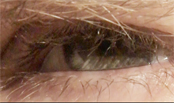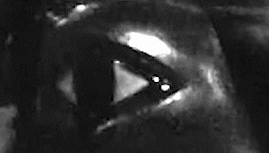multimodal essay/dcoumentary Video series aimed at affective capture & technical vision
Click on an Eye to enter
some thoughts:
How much face must we see to translate the modifications of flesh into the feelings of others? How close is too close? How close is too close for binocular vision? Worst day and Good Day are two parts in a documentary video series called LucidEyes, which attempts to capture the threshold across which bodily affect becomes visible emotion.
What are the necessary embodied context cues or environmental context cues that help us see emotion in the eyes and faciality of others? Human binocular vision requires a certain distance to resolve an image whereas the singularity of technical vision possessed by the camera can capture the eyes of others with less space between the camera body and the body being seen.
When we look at one another through our eyes, we must keep a certain distance for our eyes to register each others' intimate emotions. The camera requires less distance, but by getting "closer" it also captures corporeal affect, the tension of the skin, the dilation of the iris, the rhythms of blinking, and the architecture of the eye socket. This affective register of flesh and corporeality precedes emotional cognition. To play with the viewer's own affective/emotional engagement, responses to different themes were layered onto each other. For example what happens to our understanding of emotion if a "good day" narration may be read coherently on a "worst day" face? Different genres of music were also added to play with the external contexts that affect our understanding of what we see.
The videos were shot and edited to create variable contexts, faces and eyes through which we practice reading variable affect as particular emotion.
The footage was shot in 2009-2010 in hotel rooms and other non-personal spaces sitting next to a bright window in an otherwise dark room. Participants were asked to narrate memories along several pre-selected themes, but with the caveat that they not actually tell the story of what happened but rather tell the story of their bodies as it happened. They weren't told the themes in advance.


